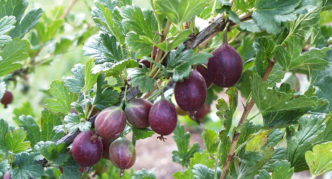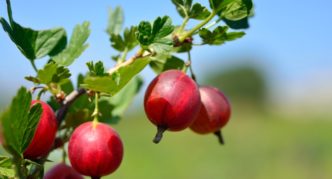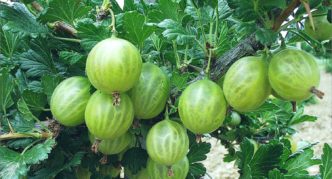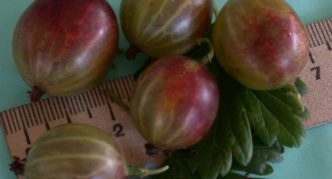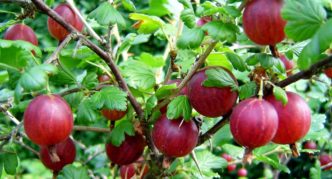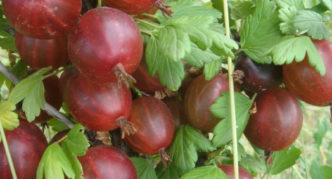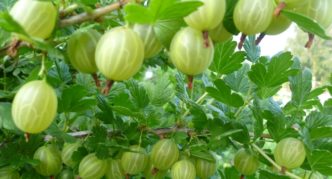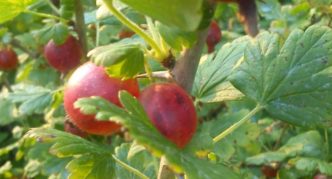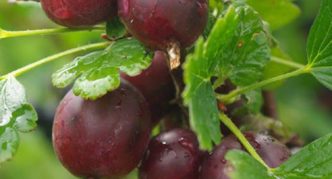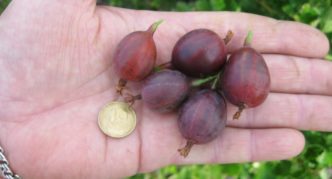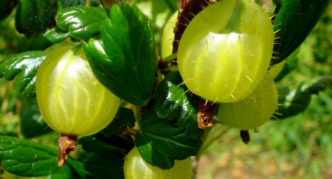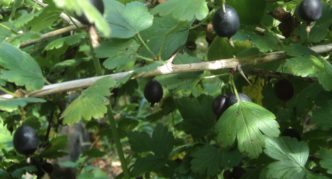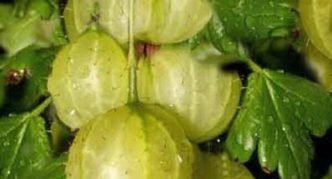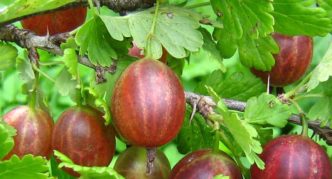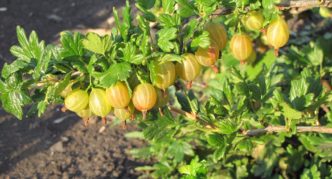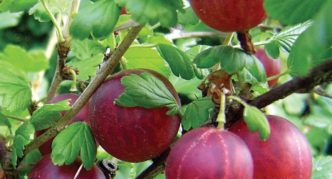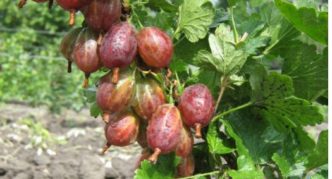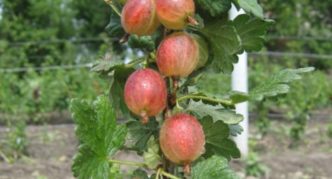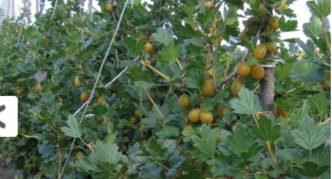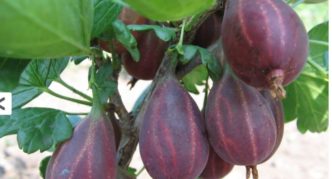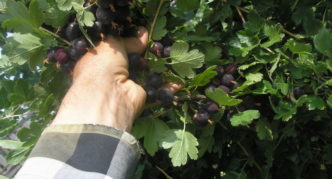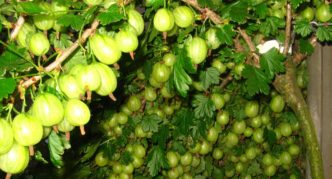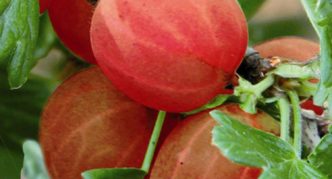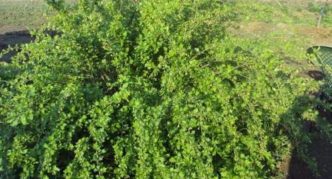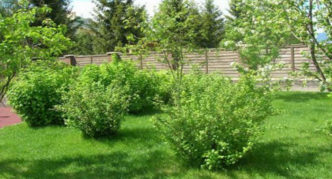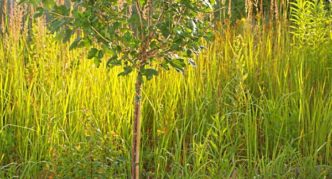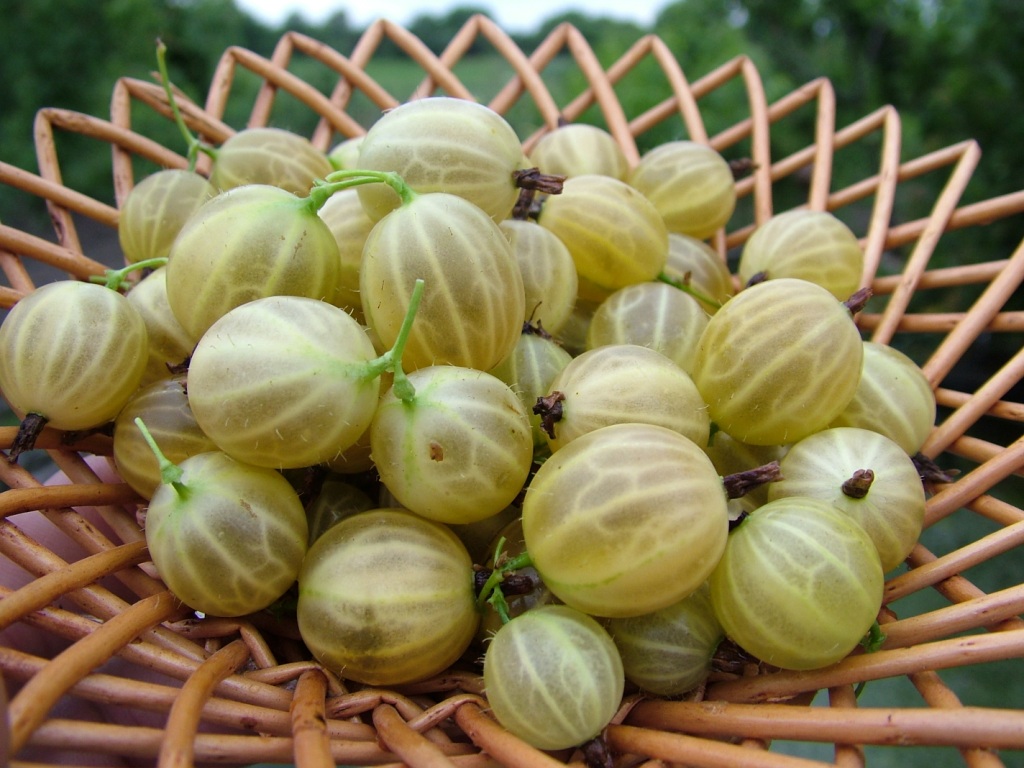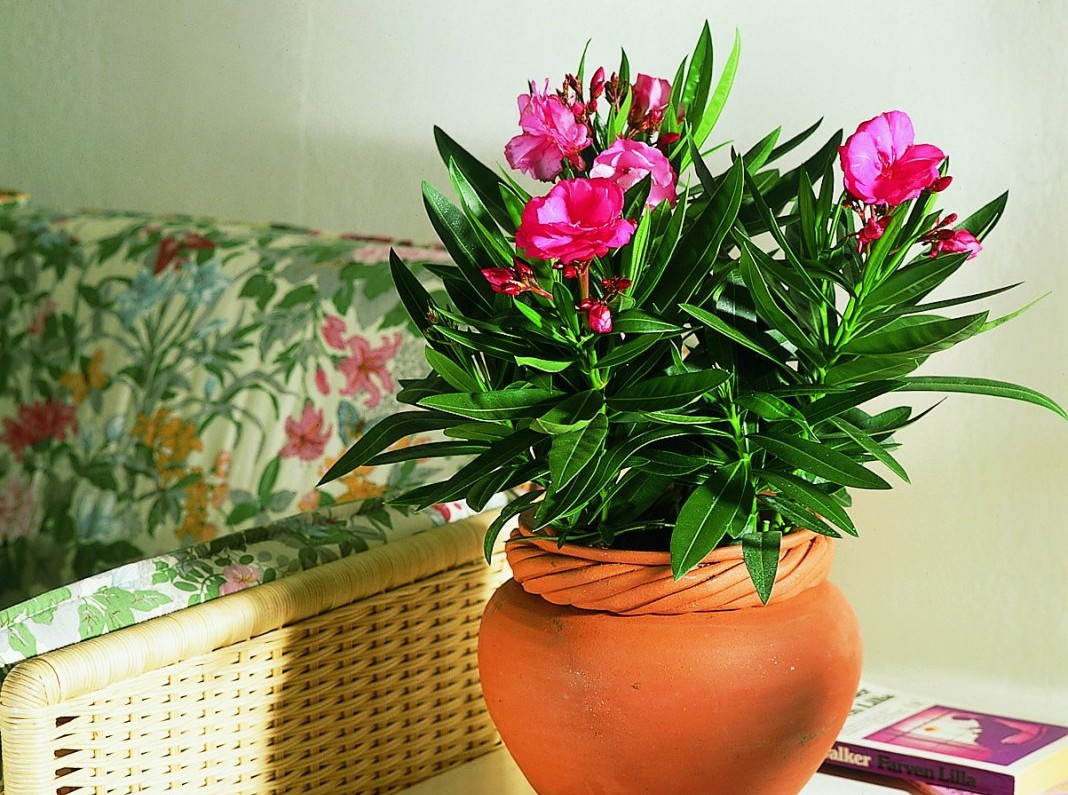Excursions into the history of the appearance of gooseberries are generally entertaining and informative. But it is no less interesting to consider each variety separately, to identify its advantages and disadvantages in order to plant and grow in your garden.
Content
Meet the gooseberry
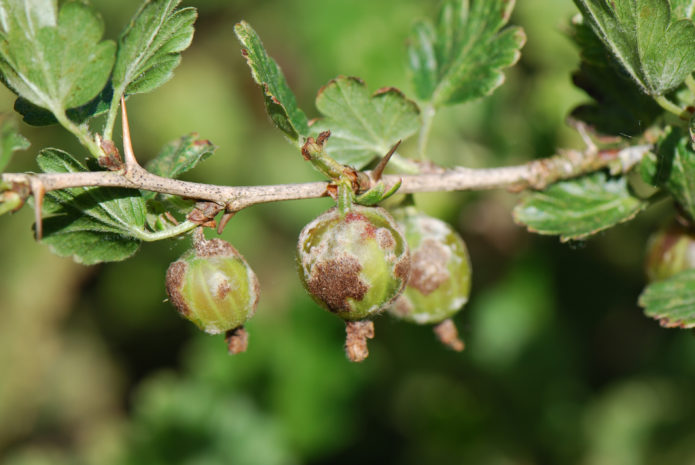
The mealy fungus affects leaves, fruits and shoots, covering them with a white coating, which then turns brown and leads to the death of the affected part
So, gooseberry is a shrub up to two meters high. During an active life (up to 40 years), it constantly renews itself, forming basal shoots. Therefore, caring for the bush includes periodic thinning, otherwise the branches will wither, the berries are crushed and the variety will degenerate. The first 7-10 years are considered to be the most productive period. The advantage of the culture is annual fruiting with an average yield of 5-12 kg per bush.
Since the times of Kievan Rus, the overseas berries "kryzhbersen", "agryz" or simply gooseberries have been known, loved and actively grown on private farms. If you do not take into account the vulnerability to spheroteka (American powdery mildew), the fruit shrub is enviable unpretentiousness. Like a camel thorn, the gooseberry progenitor grew up in extreme conditions. Maybe that's why he easily tolerates small droughts, loves the sun, breeze, does not freeze in severe winters and blooms very first in the garden.
By origin, gooseberries are divided into 2 types - European and American. Varieties from Europe are famous for large fruits with good taste, but they often get sick, it is difficult to reproduce. American gooseberries, on the other hand, are easily propagated by layering and green cuttings and are disease resistant. But it is very prickly, the berries are small, with a mild taste.
Breeding work led to the emergence of a third group, the American-European one, which incorporated the best qualities of the first two:
- medium to high resistance to disease;
- winter hardiness;
- good yield;
- big tasty berries.
What is the difference between domestic and foreign gooseberries
European breeders relied primarily on the large-fruited gooseberry. It is no secret that almost laboratory conditions are created for the bushes for tremendous success. The record holder was a variety of English selection London with berries weighing 54 g. But large-fruited varieties are capricious:
- London is highly vulnerable to recurrent frosts;
- Monstroase without timely thinning sharply reduces the yield;
- Jolie printer needs 3-4 sprays against pests per season.
The geographical position of Russia is such that the gooseberry survival rate in difficult climatic conditions - from the sultry south to icy Siberia - is put in the first place. Moreover, many varieties have large berries and good yields. For example, in Siberian gardens, the domestic Lada produces up to 5 kg of fruit per bush, and in Rose-2 the average berry weight is up to 10 g.
In addition, large-fruited varieties include:
- Date fruit;
- Beryl;
- White triumph and others.
Photo gallery: large-fruited gooseberry varieties
- Large-fruited variety, berries the size of a good plum (54 g)
- Pink-2, of course, has a more modest size than London, but the berries are also good, up to 10 grams
- Beryl has large green berries (up to 9 grams) and a sweet taste
- Date berries - round, with a dark purple bloom, can reach up to 20 grams in weight
Gooseberry classification
One gardener looks at the berries, while another is more important than a branch without thorns - each variety has its own zest that is worth attention. We offer a classification based on key features that determine the "professional suitability" of a shrub for your garden.
Thorns
The gooseberry harvest is perhaps the most unforgettable moment, the complexity and duration of which is directly proportional to the degree of roundness of the branches. The thorns differ in length, thickness, color can be pointed upwards, downwards or perpendicular to the branch. And as regards the location of the thorns, complete anarchy is observed, for example, in the Cooperator, Kubants, Nekrasovsky, only the lower half of the shoots is ringed, in the Moscow red, Black velvet, thorns grow only on annual shoots, and then completely disappear. In Captivator and African, branches are ringed closer to the base and shed thorns in autumn, but young shoots of Smena and Dates can be without thorns at all at the tops.
Strongly spiked
Sharp thorns are no problem for lovers of large, sweet berries. After all, almost all strongly thorny varieties (Black Negus, Yubileiny, Zashchitnik, Donetsk Krupnoplodny, etc.) are distinguished by excellent yield and strong, rich taste. In order not to get hurt on sharp thorns, experienced gardeners recommend harvesting early in the morning, before the dew melts. At this time, the thorns become soft, will not harm your hands.
“… While trying berries of other thornless varieties, I have not noticed a VERY GOOD taste in any of them - ordinary gooseberry, sometimes just mediocre. They weren't a celebration of taste! Apparently, after all, "prickly genes" have multiple effects, and affect the palatability of gooseberries. "
Studless grades
Perhaps the main and indisputable advantage of such a gooseberry is its safety for children. The superiority of taste or yield of thornless over all others is an unresolved question and depends only on the degree of adherence to these varieties:
- Gulliver - easily survives attacks of powdery mildew and frosts. The small size of the berries is offset by a delicate sweet and sour taste.
- Consul - the berries are not only tasty, but also with a high content of vitamin C. The harvest is processed on site, because the skin is thin and delicate fruits cannot withstand transportation.
- Matveevsky - medium spreading bushes require a certain area to the detriment of other plantations, but large berries (up to 4.5 g) are very tasty and do not crumble for a long time.
- Eaglet - has an excellent yield, up to 6.6 kg of berries per bush, tolerates frost well.
- Redball is a combination of early maturity, with strong immunity to various ailments.
Video: thornless gooseberry
Ripening terms
Gooseberry ripening periods are divided into three periods - early, middle, late, with two intermediate periods - mid-early and mid-late (the weather often makes its own adjustments). Early-maturing gooseberry flowers appear in early April and may suffer from recurrent frosts. Late-ripening blooms in early May, so the chance to keep the ovary is higher. Only 2-3 bushes of different maturity will help provide you with fresh berries for the whole summer.
The early ripening (ripening period I – II decade of June) includes:
- Spring - with all the positive qualities that make it possible to give a good harvest, the variety has a not very pleasant feature: ripe berries do not crumble, do not crack, but gradually become fresh, so you need to harvest Spring on time.
- Grand - has large dark red juicy berries, the weight of which reaches 15 g, it is easy to pick them, because the variety is slightly thorny.
- Affectionate - is a compact bushes with graceful thornless shoots, allowing you to effortlessly pick berries weighing up to 7 g, fruitful.
- Gentle - in many ways similar to Laskov, slightly spiked, it needs to be cut regularly.
- Pax (English selection) - famous for berries weighing 6-10 g, young shoots have almost no thorns, and those that are, fall off over time;
- Favorite - well resistant to spheroteca and insects, studded with triple thorns, large berries, up to 4.3 grams, yellowish.
Photo gallery: early ripening gooseberry varieties
- Pax gooseberry bushes bloom at the end of April
- Grand blooms in spring, fruits are large, up to 15 grams. weight
- The yellowish berries of the Lyubimets ripen by July, have a rich sweet and sour taste
Mid-early varieties (fruiting dates: III decade of June - I decade of July):
- Sadko - begins to bear fruit from about the 20th of June, the yield is 6 kg per bush, the berries are large, beautiful, tasty - in a word, a song.
- Minx is pleasant in all respects: there are no thorns, it is resistant to frost and diseases, the berries are small, but the vitamin C content is high - 47.5 mg per 100 g.
Varieties of medium ripening (bears fruit in the II-III decade of July):
- Nekrasovsky - medium spreading bushes, berries of universal purpose, but fresh they are especially good due to the unique plum flavor.
- Garkate (Latvian selection) - the standard set of qualities is complemented by large dark purple berries (3.5-4.1 g).
- Nova - mid-season, disease resistant, no thorns in the fruiting zone. The berry weighs 6.5 g, sweet, deep red, universal use.
- Purman is medium-sized, resistant to spheroteca, kidneys freeze under severe winters. Sour, fragrant, cherry-colored fruits with pubescence, weighing 3.4-4.6 g.
- The souvenir is a completely "independent" variety: it does not get sick, does not freeze, it grows well replacing shoots, the berries reach 9 g, the yield is stable.
Medium late (fruiting dates: III decade of July):
- Aristocrat - good endurance, and the mass of berries (up to 4.2 g), and there are almost no thorns, but the volume of the harvest is highly dependent on weather conditions.
- Captivator is an excellent persistent and hardy thornless variety with berries weighing up to 6 g (incomparable in freezing), these qualities are fully manifested if the gooseberry grows in a windproof place.
- Romance - slightly spreading bush, the lower part of the shoots is medium-spine. Winter and disease resistant. Berries weighing 3.4–4.8 g, dark red, with a waxy coating, dessert taste.
- Sunbeam - its yellowish-green berries actually look like specks of sunlight. The variety is hardy, slightly thorny, the bush thickens quickly, needs regular pruning.
Photo gallery: mid-early, medium and mid-late gooseberry varieties
- Mid-early gooseberry variety Sadko will delight you with berries by the end of July
- Medium late gooseberry variety Captivator ripens towards the end of summer
- Gooseberry Aristocrat not only ripens early, but also pleases the gardener with large berries
Late gooseberry (ripening dates: July III - August I decade):
- Korshudin is an amateur variety, has no pronounced signs, with the exception of thin, like needles, thorns on young shoots, the berries are small, sweet and sour.
- The defender is prickly, the ability to withstand low temperatures and resist fungal infections is at an average level, the yield is excellent.
- Mukurines - gives high yields of berries with a caliber of more than 7 g, medium-spine.
- Pokrovsky - resistance to all unfavorable factors at altitude, large berries.
- Seedling Smena - has bushes up to 1.8 m and beautiful berries - pink with green pulp, small thorns.
Photo gallery: late gooseberry varieties
- Gooseberry Korshudin does not have any special competitive advantages - it ripens late, the berries are small, the taste is average
- Protector berries are dark, almost black, with a pleasant aroma and dessert taste
- Mucurines is recognized by gardeners for its large, juicy berries, excellent taste, and disease resistance.
Self-fertility
According to the ability to set a crop independently, the gooseberry is divided into self-fertile (self-pollinating) and self-fertile, requiring a pollinator variety. Self-fertile varieties include:
- Belarusian sugar;
- Russian;
- Masheka;
- Plum;
- Change;
- Anniversary;
- Russian red;
- Prune;
- Chelyabinsk green;
- Chernomor;
- Black drop;
- Record.
They have excellent yields, medium-sized berries. Prune, with a delicate aroma of plums, is an excellent wine material. Reduced self-fertility is inherent in the Chelyabinsk green, Chernomor, Black drop. The record is a self-infertile variety. If there are only self-fertile bushes in the garden, the gardener runs the risk of being left without a crop. It is recommended to plant different varieties of gooseberries, because cross-pollination has a positive effect on the setting of berries, an increase in their size and an even shape.
Disease resistance
To date, there are only 2 varieties that are 100% resistant to spheroteca:
- Whitesmith is unpretentious to the soil (except for acidic and marshy), has berries of a magical taste, yield up to 7 kg.
- Spinefree - late ripening, thornless.
Hinnomaki, Souvenir, Smena, Pokrovsky have high resistance to the spherotek. But Varshavsky and Pushkinsky, despite their good winter hardiness, are completely helpless before this "plague."
Berry color
Multicolored gooseberry berries delight both children and housewives, because it is interesting when jams, sauces and compotes are colorful. For simplicity, gooseberries are classified according to a specific color without going into shades.
Red berries:
- The ballet is extremely winter hardy, the berries are large and transportable.
- Victoria (English selection) is a high-yielding variety, the berries easily tolerate transportation.
- Candy - super compact bushes, moderately resistant to diseases, very sweet fruits.
- Xenia (Swiss selection) - standard bush about 1.20 m high, berry weight up to 14 g, sweet.
- The charm is a standard bush, the berries are large, the disadvantage: it forms few layers.
- Masheka - berries are small, but the harvest is generally plentiful, increased immunity to spheroteka.
- Red Triumph - medium-sized fruit, fragrant, the variety bears fruit for about 40 years.
- Redball - berries are round, juicy, weighing up to 5 g, thornless shoots.
- Shershnevsky - has one-dimensional medium-sized berries, disease resistant.
Green berries:
- Baltic - thorny, sweet and sour medium berries for universal use.
- Veteran - good with stable yields of strong large berries.
- Grossular - easily tolerates drought, large berries, great for wine.
- Donetsk large-fruited - vigorous bush, berry weight up to 5 g.
- Emerald - winter-hardy, does not get sick, berry weight up to 6 g, has a delicate taste.
- Fertile green (Russia) - average disease resistance, berries up to 12 g.
- Melnikov - the berries are small, but strong, high yield, sick with spheroteka.
- Ural grapes are prickly, small berries, but with a high content of vitamin C, resistant to diseases.
- Ural emerald - its undersized bushes are well covered with snow, the tasting score of berries is 4.9 points.
- Chelyabinsk green - average disease resistance, winter-hardy, small berries, sweet.
- Memory Komarov - berries are medium, sweet and sour taste with honey aroma.
Gooseberries with yellow berries:
- Altai license plate - large berries with a ruddy cheek.
- Coral - does not get sick with powdery mildew, the fruits are juicy, medium-sized, transportable.
- English yellow - the minimum berry weight is 4 g, the harvest is formed annually, without seasons of rest.
- Golden light - easily multiplies in any way; with good watering, the berries become larger.
- Curšu Dzintars - berries are small (maximum 2.5 g), but fragrant.
- Honey - requires increased attention, but the berries are worth it - they are transparent to light, and taste like flower honey.
Purple coloring:
- Achilles - he doesn't care for hail and gusts of wind, temperatures down to -45 oC, but it does not tolerate shading and spring frosts at all, berries with a slightly spicy taste.
- Polonaise - medium-sized, medium-spine, resistant to fungi. The color of the berries is deep to black.
- Date - tolerates severe winters, but is susceptible to fungal infection, the shoot-regenerating ability of bushes is weak. These disadvantages pay off with above average berry size and yield.
- Generous - so named for the generous harvests, sourness dominates the taste of berries.
Photo gallery: multi-colored gooseberry varieties
- Gooseberry Masheka will color your garden with red round berries
- Honey Berries are like gems and shimmer beautifully in the sun
- Gooseberries Ural emerald - large, round, green in color with white veins
- Berries of the Generous - round, deep purple hue, almost black in extreme ripeness
Berry shape
Not only the color can surprise gooseberries, but also the shape of the berries:
- oval - Altai license plate, Harlequin, Grand, Krasny Vostok, Masheka, Sadko, Sunny bunny, Ural emerald, Ural pink, Date;
- spherical - Candy, Kazachok;
- pear-shaped - Warsaw, Dessert, Defender, Honey, Cooperator, Fertile green, Pokrovsky, Commander;
- ovoid - Garkate, Golden Light, Leningrad, Black Negus;
- barrel-shaped - Malachite.
Resistance to mechanical damage
The strong skin protects ripe gooseberries from damage from pressure, bumps and drops. This factor is also important for harvesting fully ripe berries, which will look beautiful in compotes and jams, and for transporting products. The strongest were the berries of the varieties Russian, Serenada, Yubileiny. Among the most gentle were Chernomor, Kazachok, Yubilyar, Krasnoslavyansky, Shalun.
Photo gallery: common gooseberry varieties
- And the name is funny, and the berries seem to wink, and the taste is excellent, sweet and sour
- It is easier for Krasnoslavyansky to “pull” a bountiful harvest on the trellis
- Berries of Kurshu Dzintars look like autumn foliage in yellow-orange shades
- Serenade, a gooseberry popular in the Central Black Earth Region, is recognized by the teardrop-shaped purple berries.
Varieties for cultivation in various regions
The territories where it is possible to grow gooseberries are located in different climatic zones - from temperate continental (European part of Russia) to sharply continental (Eastern Siberia). Consequently, the zoning of a variety or its ability to withstand the peculiarities of local weather is of paramount importance. Good results are also obtained from the use of foreign-bred varieties growing in similar conditions.
Varieties for North-West Russia
Growing gooseberries here is like an extreme sport, the local natural conditions are so difficult. In the northwestern part of the region, winters are relatively warm and summers are cool.The northern tip, on the contrary, has a harsh winter and a fleeting warm summer. In such conditions, in the first place, next to frost resistance, gooseberry high resistance (resistance) to fungal infections is put. Berries of local varieties are usually medium-sized: 2.5-2.8 g.
- Pioneer - medium early, medium spine, disease resistant. Small berries, good taste.
- Lefora seedling is relatively sphero-resistant, annual harvest.
- Change - the bushes require constant thinning. Productivity 5-6 kg per bush, berries hang for a long time without losing their presentation.
- Fireworks - does not get sick, does not freeze, the lower part of the shoots is numb, the berries are large, up to 10 kg of berries are removed from the bush.
Some Finnish varieties that are neutral to powdery mildew feel at home here:
- Mid-season Finnish - thorny low bushes, berries, leveled in size;
- Finnish red is a medium late self-fertile variety with dark cherry berries;
- Hinnonmainen Keltainen - the berries are medium, despite the thin skin, quite strong, versatile.
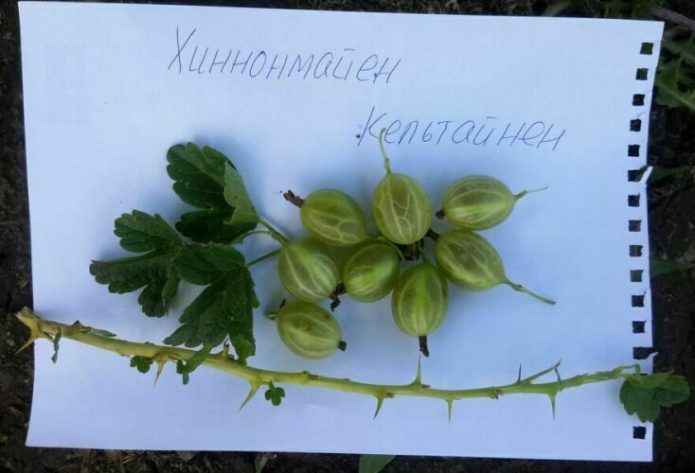
Finnish gooseberry varieties, including Hinnomainen Keltainen, have settled down well in Northwest Russia
Varieties for the Russian South
In the southern region, primarily drought-resistant gooseberries take root:
- Kubanets - early self-fertile, sprawling, resistant bush, berries for universal use.
- Russian - berries are one-dimensional, popular for the production of delicious light wine, yield 4-10 kg per bush. Young bushes are spreading.
- Kuibyshevsky - the crown quickly overgrows with young shoots, therefore it requires regular thinning.

Gooseberry Russian (Russian yellow) is not afraid of drought and easily withstands the climate of the South of Russia
Varieties for central Russia
In general, the conditions of the middle zone are favorable for growing gooseberries, but no one has canceled the famous Russian frosts, recurrent frosts or prolonged cool springs. Abnormal summer heat or showers are also becoming commonplace, so the requirements for the endurance of gooseberry varieties have not been canceled.
Varieties of medium ripening in the Central Black Earth Zone are characterized by high winter hardiness, immunity to diseases, and have large berries (up to 6 g). Thorny bushes.
- Plum is very prickly, the thorns are thick, directed downward, that is, it is easy to reach for the berry, but it is problematic to get it back. The variety favorably differs in annual fruiting up to 12 kg per bush and one-dimensionality of berries (5 g).
- Yubileiny (Research Institute named after I.V. Michurin) - tolerates thaws, berries are juicy, sweet and sour taste, but without aroma with an increased (37.7%) content of vitamin C.
- Krasnoslavyansky (Leningrad selection) - fruiting begins from the second year, but reaches a peak only after 4–5 years. Productivity 6-7 kg per bush, one-dimensional berries, dessert taste.
Mid-late varieties are vigorous bushes with high resistance to diseases, severe winters. The mass of berries ranges from 2.9 to 3.5-4 g.
- Cossack - medium-spiky, the disadvantages include the spreading of the bush, the crushing of berries in unfavorable years.
- Chernomor - weakly spreading bushes, drooping tops of the shoots. Weakly spiny, easily propagates by shoots. The berries are tender but strong.
- Sirius (Gulliver) is a compact bush with a yield of 4–7 kg. No thorns. Fruits are not one-dimensional, dark red. The skin is of medium thickness.
- Serenade is a late-ripening variety. Berries have a delicate sweet and sour taste, transportable.
Early and mid-early varieties for the Moscow region:
- White nights - the variety is characterized by stable fruiting, resistance to spheroteca. The bush under the weight of the harvest from compact becomes spreading, the tops of the shoots are blackberry-colored. Self-fertility is more than 55%.
- Moscow red - it is worth taking care of protective measures against the spheroteca in order to be able to feast on large sweet berries.
- Invicta (English selection) is a powerful, sprawling, thorny bush.It tolerates winter well, resists fungal diseases. Berries weighing 6-8 g, universal, transportable.
- Grape (Russian) - on the one hand, at the time of stable fruiting, the bush enters only 6-7 years old, small berries. On the other hand, the yield remains consistently high.
- Date - not afraid of either winter or disease, the berries are sweet, strong, yield up to 8 kg per bush.
Medium and mid-late varieties:
- Beryl - bushes of medium height, do not get sick, winter well, almost without thorns. The berries are small, but sweet, for universal use, excellent yield (up to 10 kg).
- Hinnomaki (Finnish selection) - not affected by fungus, frost-resistant. The berries are large (4 g), with a good taste, but quickly crumble.
- Belarusian sugar - average resistance to the fungus, abundant annual fruiting is observed for 10-12 years. Bushes are tall, prickly. Maximum berry weight 8.5 g, dessert flavor.
- Northern Captain - successfully resists both diseases and pests. The bushes are medium spreading with an average height of 1.5 m, the lower part of the shoots is prickly, but there may be no thorns at all. The berries can hang on the bush for a long time without losing their qualities.
Early varieties for the Middle Volga and Lower Volga regions:
- Ural grapes are vigorous semi-sprawling bushes, covered with large emerald-green berries, but they ripen quickly, so harvesting is required in one step, the pulp is rich in vitamin C.
- African (Saratov Experimental Station) - medium early, stable in all respects. Medium height, with almost no thorns. Berries (2.9–4 g) are dark plum in color with a light downy taste of black currant.
- Our sugar is a cosmopolitan variety, distributed over most of the world. It grows well both in the northern regions of the country, and in the central or southern regions (it is recommended to plant it in partial shade here).
Photo gallery: gooseberry varieties for central Russia
- The African has beautiful black berries of sweet and sour taste, the variety is unpretentious, easily withstands the conditions of central Russia.
- Invicta - rather tall, spreading, large berries (up to 8 g) hang in clusters from the branches
- Hinnomaki Red is a drought and winter hardy variety with round red berries, sweet and sour taste
- Black sweet berries of Chernomor receive consistently high reviews from gardeners
Photo gallery: shapes of gooseberry bushes
- Sprawling bushes require a lot of space and regular pruning
- Green on green - a corner of the garden with compact gooseberry bushes resembles the courtyard of the English aristocrats
- The stamp form is ergonomic, beautiful and almost does not get sick
Varieties for the Urals
Severe Ural winter and spring frosts down to -10 oC often lead to freezing of the buds, a decrease in the taste and size of the berries. A kind of protection against freezing is the method of planting gooseberries - the root collar is surrounded by an earthen roller. In winter, the branches are bent and pinned to the ground, the bush is covered with snow.
Varieties adapted to the conditions of the Urals:
- Cooperator - perfectly tolerates natural disasters, but cannot always withstand the "attacks" of the fungus. Slightly spreading bush. Thin-skinned berries are large, good taste.
- Smart - slightly spiked, resistant to disease. The average weight of the berry is about 5 g, the taste is dominated by sweetness.
- Stanichny - a medium spreading bush, does not suffer from American powdery mildew, sometimes freezes. The berries are small and tender.
- Anniversary - withstands frost, but vulnerable to fungus. The berries are quite large with a dense skin. The berry weight is 5.5–6.5 g, the color is bright yellow with red veins, with a dense skin. Up to 4.2 kg of yield is obtained from the bush.
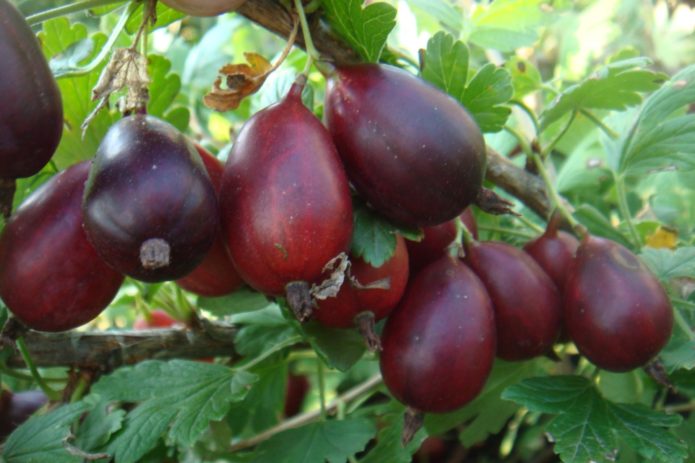
Winter-hardy self-fertile Cooperator pleases the owner with delicious fragrant berries with minimal maintenance
Varieties for Siberia
The Siberian climate is generally harsh for plants - in the western part the temperature is tolerable for gooseberries from -15 to -30 oC is significantly reduced by winter winds.Winter in the eastern part is calm, but the temperature drops below -40 oC. Therefore, the main requirement for gooseberries remains unchanged - frost resistance. In addition, the bushes are necessarily covered with snow.
In Western Siberia, the variety has been successfully tested for a long time:
- Grossular is a medium spreading bush, almost without thorns, withstands short droughts. The berries are large, making excellent wine.
- Chelyabinsk green (Ural selection) - self-fertile, medium early, vulnerable to drought, fungus. Small berries have a distinct sweet taste. Up to 3.5 kg of berries are taken from the bush.
- Harlequin - late ripening, not sick, abundant harvest.
- Krasny Vostok is immune to diseases, slightly spiny. Berries of regular taste, large.
- Commander (Vladil) - spring frosts do not affect flowering, therefore, the variety has a high yield - 7-8 kg of berries from a bush.
- Leningrader - late ripening, can be amazed by spherotek. It is famous for its high yield (over 7 kg) and large 10-gram berries.
- Senator is a vigorous bush, medium-sized berry, characterized by a delicate taste and aroma.
- Ural pink - has standard indicators of stability and endurance. The size of the berries is slightly over average, the taste has received the highest tasting rating.
Especially for Eastern Siberia, the Ural emerald was created - an early ripe variety with low bushes, which are well covered with snow and survive frost.
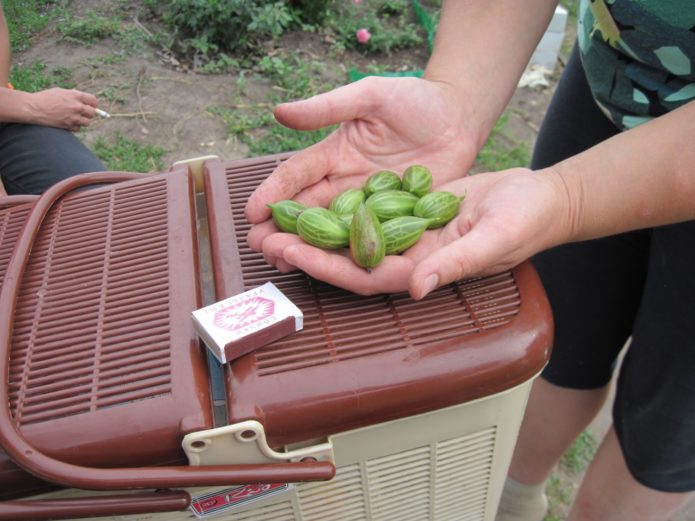
The giant berries of the Ural emerald impress even an experienced gardener, and they grow beautifully even in harsh Siberia
Varieties for Ukraine
The western regions of Ukraine are characterized by cool summers and damp winters, while the southeast languishes from the summer heat, and winter frosts reach -25 oC. Consequently, if in one area gooseberries are susceptible to powdery mildew, in another they suffer from drought. A popular variety in Ukraine is considered:
- Red is an early medium variety with characteristic powerful bushes, the tops of the shoots are purple - decorative. Highly resistant to adverse weather conditions and diseases. Weakly spiked. The average weight of berries is 6.5 g.
- Neslukhovsky (Lviv selection) - early, strongly thorny, winter-hardy, weakly affected by spheroteka. The berries are one-dimensional, large, do not spoil for a long time on the bush.
- Carat (Lviv selection) - does not get sick, winters well, interesting berries - dark cherry outside and greenish brown inside.
- Dessert - a visiting card of the variety, dark red, like cherries, large berries.
- Snezhana - relatively vulnerable to powdery mildew, winters well, table-flavor berries.
- Black velvet - valued for large juicy berries weighing up to 10 g.
Varieties for Belarus
The moderate continental climate of Belarus causes high humidity in winter and summer, creating ideal conditions for garden sores. Therefore, resistance to powdery mildew becomes a priority.
A typical Belarusian variety has become:
- Masheka - the taste of berries causes a lot of controversy, some people find it interesting, others find it bland. Be that as it may, Masheka does not have bad harvest years.
- Belarusian red (local selection) - fruitful, winter-hardy. The berries are medium, they do not stand out with a special taste;
- Mashenka (local variety) - a small bush with strong shoots, high-yielding;
- Ravolt is self-fertile, barely amazed by spheroteka (and according to some gardeners, does not get sick at all). The berries are large, aromatic.
- Green rain - compact bushes with slightly thorny shoots, the variety is resistant to weather disasters. The berries are small, but the yield is impressive - up to 5 kg per bush.
- Olavi is winter hardy. Small berry - 3 g, dark pink, tasty, versatile in use.

Olavi feels great in Belarus, and refreshing sweet and sour berries are used for a variety of culinary purposes (pies, preserves, jams, etc.)
Video: exhibition-seminar on promising gooseberry varieties
Gooseberry is a unique fruit and berry crop that will reward a hundredfold even for minimal care. The tenacity of this shrub, the annual harvests, can inspire respect and sincere gratitude.
